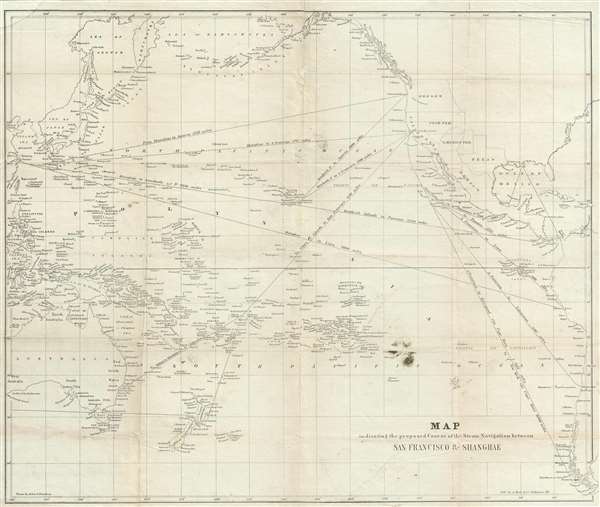Digital Image: 1849 Stansbury Map w/ Steamship Lines btwn Shanghai and San Francisco
ShanghaiSanFrancisco-stansbury-1849_d
Title
1849 (undated) 19 x 23 in (48.26 x 58.42 cm) 1 : 33000000
Description
FOR THE ORIGINAL ANTIQUE MAP, WITH HISTORICAL ANALYSIS, CLICK HERE.
Digital Map Information
Geographicus maintains an archive of high-resolution rare map scans. We scan our maps at 300 DPI or higher, with newer images being 600 DPI, (either TIFF or JPEG, depending on when the scan was done) which is most cases in suitable for enlargement and printing.
Delivery
Once you purchase our digital scan service, you will receive a download link via email - usually within seconds. Digital orders are delivered as ZIP files, an industry standard file compression protocol that any computer should be able to unpack. Some of our files are very large, and can take some time to download. Most files are saved into your computer's 'Downloads' folder. All delivery is electronic. No physical product is shipped.
Credit and Scope of Use
You can use your digial image any way you want! Our digital images are unrestricted by copyright and can be used, modified, and published freely. The textual description that accompanies the original antique map is not included in the sale of digital images and remains protected by copyright. That said, we put significant care and effort into scanning and editing these maps, and we’d appreciate a credit when possible. Should you wish to credit us, please use the following credit line:
Courtesy of Geographicus Rare Antique Maps (https://www.geographicus.com).
How Large Can I Print?
In general, at 300 DPI, you should at least be able to double the size of the actual image, more so with our 600 DPI images. So, if the original was 10 x 12 inches, you can print at 20 x 24 inches, without quality loss. If your display requirements can accommodate some loss in image quality, you can make it even larger. That being said, no quality of scan will allow you to blow up at 10 x 12 inch map to wall size without significant quality loss. For more information, it is best consult a printer or reprographics specialist.
Refunds
If the high resolution image you ordered is unavailable, we will fully refund your purchase. Otherwise, digital images scans are a service, not a tangible product, and cannot be returned or refunded once the download link is used.
Cartographer S
Arthur Joseph Stansbury (1781 – September 27, 1865) was an American Presbyterian minister and newspaperman active I the first half of the 20th century Stansbury was born at 42 broad Street, New York City. He studied at Columbia College, graduating in 1799. Shortly thereafter he seems to have become involved with his brother Abraham Stansbury in a bookselling, bookbinding, and stationary business based at No. 114 Water-street opposite the Old Coffee-house. Three years later in 1803 he married Susan Brown of Boston. Changing careers, he was licensed for the ministry in 1810 and worked as an itinerant preacher in New York and New Jersey. Around 1822, Stansbury again abruptly changed careers becoming a newspaper reporter. He eventually took work with the Washington D.C. National Intelligencer focusing on court debates and congressional activity. He was admired for his copious and detailed transcriptions court events. In addition to his reporting work, Stansbury was a noted artist, lithographer, and poet. He made a well-known portrait of John Quincy Adams on his deathbed which he sold commercially. He also wrote children's books. Little is known of his cartographic activity. He published a map of the northern part of the state of New York with Amos Lay in 1801 under the imprint of Brown and Stansbury (John Brown and A. J. Stansbury's brother Abraham Stansbury). More by this mapmaker...
August Hoen and Company (fl. c. 1840 - 1981) was a Baltimore based engraving and lithography firm active in the middle part of the 19th century. A. Hoen and Co. was originally founded by Edward Weber under the name 'E. Weber and Company.' Weber died in the early 1850s and his company was taken over by German immigrant August Hoen (18?? - 1886) and his brothers, Henry and Ernest Hoen. As general interest lithographers, the Hoen firm's corpus includes posters, cigar boxes, sheet music covers, and posters as well as maps. They are best known for their pioneering multi-color lithographic techniques. After the death of August Hoen, the business passed on to his son, Albert Hoen. Another son, Earnest A. Hoen, moved to Richmond, Virginia and opened a branch of the firm there where he was granted a charter to produce Civil War era Confederate Currency. Their contributions to the cartographic field are generally in association with engraving and printing work done for Jacob Monk and the U.S. Geological Survey. The Hoen family maintained an active interest in the firm for the next 100 years or so until it finally filed for bankruptcy in 1981. Learn More...

